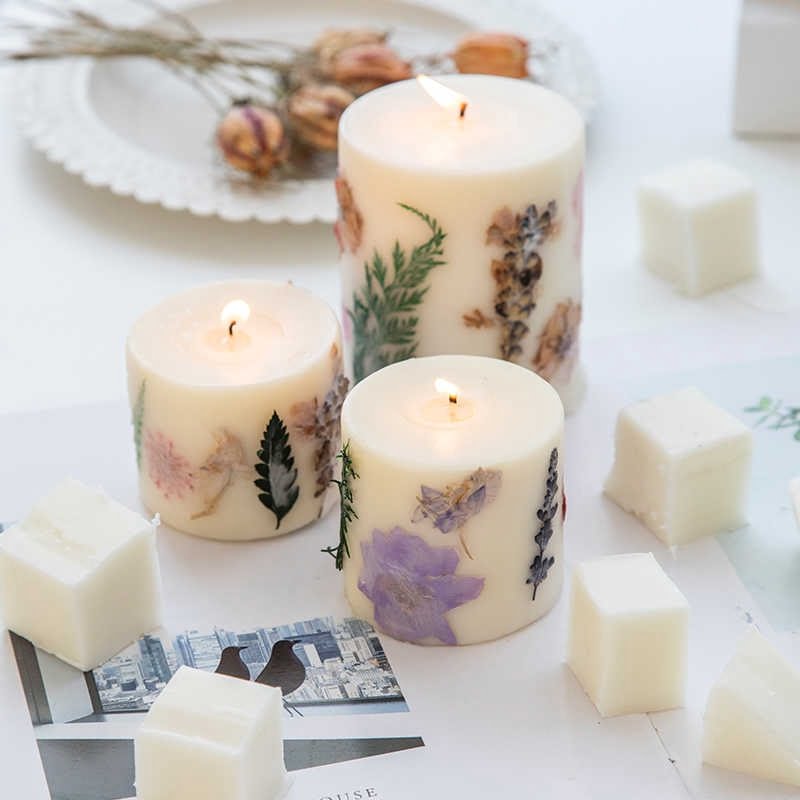Candle making has been a cherished craft for centuries, and one that continues to captivate enthusiasts today. Among the wide array of materials available for candle making, one in particular stands out for its unique properties and historical significance – bayberry wax. In this article, we will explore the art of making bayberry wax candles and delve into the various aspects that make them so special.
Handmade candles have always held an irresistible charm – they exude warmth, create ambience, and add a personal touch to any space. The process of making candles at home allows individuals to unleash their creativity while indulging in a time-honored tradition. Bayberry wax, derived from the berries of the bayberry shrub, adds an extra layer of allure to these creations.
Throughout history, bayberry wax has been treasured for its versatility and captivating fragrance. It boasts a natural golden hue and emits a subtle aroma reminiscent of fresh berries and the serene outdoors. The scarcity and labor-intensive nature of extracting this wax has given it an elevated status among candle enthusiasts. Today, artisanal candle makers thrive on the challenge of working with bayberry wax, as it yields candles that are not only visually appealing but also offer exceptional quality.
In the following sections, we will explore the many facets of making bayberry wax candles – from gathering bayberries sustainably to rendering the wax itself. We will also delve into choosing the right wick for optimal burning performance and imparting personalized scents and decorations to your creations. With step-by-step instructions and troubleshooting tips along the way, you will be well-equipped to embark on your own candle-making journey with this exquisite material: bayberry wax.
History of Bayberry Wax
Bayberry wax has a rich history that dates back centuries. It was primarily used by early American settlers and Native American tribes for various purposes due to its unique properties and availability. Understanding the history and cultural significance of bayberry wax can add an extra layer of appreciation to the art of making bayberry wax candles.
Origins of Bayberry Wax
Bayberry wax is derived from the fruits of the bayberry shrub, scientifically known as Myrica cerifera. This shrub is native to the coastal regions of North America, particularly in areas such as New England and the Mid-Atlantic states. The waxy coating found on the bayberries contains natural fats that can be extracted to create a smooth and fragrant wax.
The use of bayberry wax dates back to colonial times when it was primarily used for making candles. Early American settlers discovered that by boiling the berries, they could collect the valuable wax that floated to the surface. However, gathering enough berries to produce a significant amount of wax was a labor-intensive process, making it highly prized.
Cultural Significance
Bayberry wax candles held great cultural significance in early America. With limited access to beeswax or other candle-making materials, bayberry wax became a cherished resource for both practicality and symbolism. It was often used during special occasions such as Christmas or New Year’s Eve celebrations when families would light these candles as a symbol of good luck and prosperity for the coming year.
This tradition eventually led to the popular saying, “A bayberry candle burned to the socket brings food to the larder and gold to the pocket.” This saying emphasizes the belief that burning a bayberry wax candle down completely would bring abundance and wealth.
In addition to its cultural importance in North America, bayberry also had historical significance in places like Europe where it was used for medicinal purposes. The leaves and bark were believed to contain healing properties and were utilized in remedies for various ailments.
Understanding the history and cultural significance of bayberry wax adds depth to the craft of making bayberry wax candles. It connects us to a time when resources were scarce, and handmade candles held both practical utility and symbolic meaning. Today, making bayberry wax candles allows us to carry on this tradition and appreciate the natural beauty and fragrance of this unique wax.
Gathering Bayberries
Bayberry wax, with its unique properties and cultural significance, is a popular choice for handmade candle enthusiasts. However, before embarking on the process of making bayberry wax candles, it is essential to gather the key ingredient – bayberries – in a sustainable and responsible manner.
When it comes to gathering bayberries, timing is crucial. Bayberries ripen in late summer or early fall, usually between August and September in North America. During this time, they turn from green to a bluish-black color and give off a distinct fragrance. It is best to wait until the bayberries are fully ripe before harvesting them for optimal quality and wax yield.
Bayberry bushes can be found in various coastal areas such as sandy beaches or marshy regions. The most common species used for wax extraction are the Myrica pensylvanica (Northern Bayberry) along the Eastern seaboard of the United States, and the Myrica cerifera (Southern Bayberry) in the southern states. Look for dense shrubs with grayish-green leaves that have a waxy texture when rubbed between your fingers.
To ensure sustainability and protect the environment, it is vital to practice responsible harvesting methods. When gathering bayberries, always leave enough berries on each bush for wildlife consumption and future propagation. Avoid overharvesting from one area repeatedly as it can deplete local resources. Instead, spread out your collection efforts across different locations to minimize impact.
By following these guidelines for gathering bayberries sustainably, you can play your part in preserving this natural resource while enjoying the process of making bayberry wax candles at home.
Rendering Bayberry Wax
To render bayberry wax from the collected bayberries, you will need a few tools and follow a straightforward process. Here is a step-by-step guide to help you successfully render bayberry wax:
- Gather your materials: You will need fresh or dried bayberries, a large pot, cheesecloth or muslin cloth, a strainer or sieve, and clean containers for storage.
- Clean the berries: If using fresh bayberries, rinse them well under cold water to remove any dirt or debris. Remove any stems and leaves that may be attached.
- Crush the berries: Once cleaned, gently crush the berries to release their natural oils. Some people prefer to use a mortar and pestle for this step, while others opt for crushing them with their hands.
- Heat the crushed berries: Place the crushed berries in a large pot and heat them over low heat. Stir occasionally to prevent sticking or burning.
- Allow wax to melt: As the crushed berries heat up, you will notice that they start to release their waxy coating. Continue heating until all the wax melts completely into a liquid form.
- Strain the liquid: Carefully pour the hot liquid through a strainer or sieve lined with cheesecloth or muslin cloth into another container. This will remove any remaining fruit solids and impurities, leaving behind pure bayberry wax.
- Allow the wax to cool and solidify: Let the strained wax cool for several hours until it solidifies into a firm disk or block.
- Store in clean containers: Once cooled, transfer the rendered bayberry wax into clean containers for storage. Make sure these containers are tightly sealed to keep out moisture and maintain optimal quality.
With these steps, you can successfully render your own bayberry wax from collected bayberries. It is important to note that the rendering process may take time, and the yield of wax can vary depending on the quality and quantity of bayberries used. Enjoy the satisfaction of knowing that you have transformed natural berries into a unique and eco-friendly candle-making ingredient.
Necessary Tools
- Large pot
- Cheesecloth or muslin cloth
- Strainer or sieve
- Clean containers for storage
Benefits of Bayberry Wax Candles
Bayberry wax candles offer several benefits that make them a great choice for candle enthusiasts. One of the key advantages of using bayberry wax is its eco-friendly nature. Unlike paraffin wax, which is derived from petroleum, bayberry wax is a natural and sustainable option. It comes from the waxy coating on the berries of the bayberry shrub, making it a renewable resource.
Another advantage of bayberry wax candles is their long burning time. Bayberry wax has a higher melting point compared to other types of wax, allowing it to burn slowly and evenly. This means that your candles will last longer, giving you more hours of enjoyment before needing to be replaced.
In addition to its eco-friendliness and long burning time, bayberry wax also offers a unique fragrance. The natural scent of bayberries adds a pleasant aroma to your candles, creating an inviting atmosphere in your home. Many people find this fragrance to be refreshing and reminiscent of the outdoors.
To further enhance the fragrance of your bayberry wax candles, you can also add essential oils or other natural scents during the candle-making process. This allows you to customize the aroma to suit your preferences and create a truly personalized experience.
With its eco-friendly properties, long burning time, and unique fragrance, it’s no wonder that bayberry wax candles have gained popularity among candle enthusiasts. Whether you’re looking to create a cozy ambiance in your home or searching for a thoughtful handmade gift idea, bayberry wax candles are sure to impress with their many benefits.
| Advantages | Description |
|---|---|
| Eco-friendly | Bayberry wax is derived from a renewable resource and is considered more sustainable than paraffin wax. |
| Long burning time | Bayberry wax has a higher melting point compared to other waxes, allowing candles to burn slowly and last longer. |
| Unique fragrance | The natural scent of bayberries adds a refreshing and inviting aroma to the candles. |
Choosing the Right Wick
When it comes to making bayberry wax candles, choosing the right wick is crucial for achieving optimal burn performance. The type of wick you select can significantly impact how your candle burns, including factors such as flame height, burning time, and even smoke production. With numerous options available, understanding the different wicks and their qualities will help you create candles that burn evenly and efficiently.
1. Cotton Wicks:
Cotton wicks are a popular choice for bayberry wax candles due to their versatility and reliable performance. They come in various sizes ranging from small votive wicks to larger jar or pillar candle wicks. Cotton wicks are known for producing an even flame with minimal smoke and soot. For bayberry wax candles, cotton core or flat cotton wicks are recommended.
2. Wood Wicks:
For those seeking a unique touch to their bayberry wax candles, wood wicks are an excellent option. These wicks are typically made from sustainably sourced wood and offer a crackling sound reminiscent of a cozy fireplace. Wood wicks provide a wide flame and typically require trimming before subsequent uses.
3. Hemp Wicks:
Hemp wicks have gained popularity in recent years due to their eco-friendly nature. They are made from natural hemp fibers without any additives or chemicals, making them an excellent option for those who prioritize sustainability in their candle-making process. Hemp wicks tend to burn more slowly than cotton ones but may require regular trimming to maintain an optimal flame height.
4. Testing Different Wick Sizes:
It’s important to note that the thickness or size of the chosen wick will largely depend on the container size or diameter of your bayberry wax candle. To determine the ideal size, it’s recommended to conduct test burns using different-sized wicks. Start with a smaller size and gradually increase until you achieve the desired flame height.
By selecting the right wick for your bayberry wax candles, you can ensure a clean and efficient burn that enhances both the aesthetic and functional aspects of your handmade creations. Remember to consider factors such as container size, desired burn time, and personal preferences when making your selection. Experimenting with different wick types and sizes will allow you to find the perfect match for your unique candle-making journey.
Scenting and Decorating Bayberry Wax Candles
Adding fragrance to bayberry wax candles can enhance the overall sensory experience and create a unique ambiance. There are several methods to scent bayberry candles, such as using essential oils, herbs, or spices. When selecting essential oils, opt for scents that complement the natural aroma of bayberry wax, such as vanilla, cinnamon, or cedarwood.
To scent your bayberry wax candles using essential oils, follow these steps:
- Start with a clean and cooled candle jar or container.
- Prepare the desired fragrance by adding 10-12 drops of essential oil per ounce of melted bayberry wax.
- Stir gently until the fragrance is evenly distributed throughout the wax.
- 4. Pour the scented wax into the prepared candle jar or container, taking care not to disturb the wick.
For a more rustic touch, consider incorporating natural elements into your bayberry wax candles. Dried flowers, herbs, or spices can add visual interest and a subtle scent to your creations. Here’s how you can decorate your bayberry wax candles with natural elements:
- Choose dried flowers or herbs that complement the scent of your candle or evoke a specific mood (such as lavender for relaxation).
- Gently press the dried flowers or herbs onto the surface of the cooled candle while it is still slightly tacky.
- Secure any loose elements with a thin layer of melted bayberry wax brushed over them.
- Allow the decoration to set before lighting the candle.
When working with natural decorations, keep in mind that some materials may pose a fire hazard if placed too close to the flame. It’s important to ensure that any decorative elements are firmly attached and located away from direct contact with the wick.
| Fragrance Options | Natural Elements |
|---|---|
| Vanilla essential oil | Dried lavender flowers |
| Cinnamon essential oil | Dried rose petals |
| Cedarwood essential oil | Dried orange slices and cinnamon sticks |
Troubleshooting
Troubleshooting: Address common issues encountered during the process of making bayberry wax candles. Provide solutions and tips for troubleshooting problems such as uneven burning or wax adhesion.
While making bayberry wax candles can be a rewarding and enjoyable craft, there may be some common issues that you encounter along the way. Fortunately, with a little troubleshooting, you can overcome these challenges and create beautiful, high-quality candles. Here are some solutions and tips to address common problems that may arise during the process of making bayberry wax candles:
- Uneven Burning: One common issue that candle makers face is uneven burning, where the wax melts unevenly and creates a tunnel in the center of the candle instead of burning evenly from edge to edge. To prevent this, ensure that your wick is properly centered in the container before pouring the melted wax.
Additionally, trim the wick to an appropriate length (around ¼ inch) before lighting it each time. This will help maintain a consistent flame and even burn. - Wax Adhesion: Sometimes, when pouring hot wax into containers or molds, it may not adhere well to their surfaces, resulting in gaps or air bubbles in the finished candle. To avoid this problem, make sure your containers or molds are clean and free from any residue that could hinder adhesion.
You can also try preheating them slightly before pouring the wax to promote better adherence. Another tip is to pour the melted bayberry wax at a slightly higher temperature as hotter wax has better adhesive properties. - Sooty Flames: If you notice dark soot forming on the rim of your candle container or excessive smoke coming from the flame while burning your bayberry wax candle, it’s likely due to an improper wick size or type. To prevent this issue, choose a properly sized wick designed specifically for use with bayberry wax candles.
It’s important to match the wick’s diameter and composition to the type of candle you’re making. For larger candles, consider using multiple wicks to ensure a clean, smokeless burn.
By keeping these troubleshooting tips in mind, you can overcome common issues encountered during the process of making bayberry wax candles. Remember that each candle-making journey is unique, and experimentation may be required to find the perfect balance for your specific needs and preferences.
Don’t get discouraged if you encounter any setbacks – they are all part of the learning experience. With practice and patience, you’ll soon be able to create stunning bayberry wax candles that burn evenly and fill your space with their delightful aroma.
Caring for Bayberry Wax Candles
Once you have successfully made your own bayberry wax candles, it is important to know how to properly care for them in order to maximize their performance and longevity. By following a few simple guidelines, you can ensure that your handmade candles continue to create a warm and inviting ambiance in your home.
One key aspect of candle care is trimming the wick. A trimmed wick will burn more evenly and prevent the flame from becoming too large or smoking excessively. Before lighting your bayberry wax candle, make sure the wick is trimmed to about 1/4 inch.
You can use a small pair of scissors or a specialized wick trimmer to achieve the desired length. Trimming the wick before each use will help maintain a clean burn and prolong the life of your candle.
In addition to trimming the wick, proper storage is essential for preserving the quality of your bayberry wax candles. Store them in a cool, dry place away from direct sunlight and extreme temperatures. This will prevent the wax from melting or discoloring prematurely. Avoid storing candles in areas with high humidity, as this can affect their burning properties.
Another common mistake when caring for bayberry wax candles is forgetting to extinguish them properly. Always put out a candle by snuffing it with a candle snuffer or gently blowing it out using a sufficient amount of force to avoid creating smoke or small embers. Avoid blowing out candles forcefully, as this can cause hot wax splatter and lead to accidental burns.
By following these tips on caring for your bayberry wax candles, you can enjoy their cozy glow and unique fragrance for many hours to come. Remember that proper maintenance ensures optimal performance and extends the life of your handmade creations.
Conclusion
In conclusion, making bayberry wax candles is not only a captivating hobby but also an enriching experience. Throughout this blog post, we have explored the history and significance of bayberry wax, as well as provided detailed instructions on how to gather and render it. We have also discussed the benefits of using bayberry wax for candle making, such as its eco-friendly nature, long burn time, and unique fragrance.
By choosing to make bayberry wax candles at home, you are not only honoring a traditional craft but also tapping into your own artistic flair. Handmade candles hold a special charm that mass-produced ones simply cannot replicate. They add warmth and ambiance to any space and make thoughtful gifts for loved ones.
While there may be some challenges along the way, such as choosing the right wick or troubleshooting common issues, do not let these deter you from embarking on this fulfilling journey. With practice and patience, you will become more skilled in creating beautiful bayberry wax candles that bring joy and tranquility into your life.
So why not give it a try? Gather those bayberries, follow the step-by-step instructions provided in this blog post, and let your creativity shine through scenting and decorating your candles. With proper care and maintenance, your bayberry wax candles will continue to burn brightly for hours on end.
Not only will engaging in this ancient craft allow you to create something spectacular with your own hands; it will also deepen your connection to nature and evoke a sense of fulfillment like no other. So go ahead – ignite your passion for candle making and enjoy the rewards of crafting these unique creations that will fill your home with beauty and serenity.

Welcome to my candle making blog! In this blog, I will be sharing my tips and tricks for making candles. I will also be sharing some of my favorite recipes.





